
Anyone who does graphics or games – any processor-intensive tasks with their laptop know they get hot, quick! Since I’ve recently started doing video editing with my laptop, it’s gotten quite warm, and in an unrelated (as it turns out) coincidence, last week I had a refuse-to-wake-after-sleep scenario. I bought a couple of new gadgets to hopefully help. (skip to the bottom to see those)
Nerd Alert!!! The CAPS lock indicator was blinking, and some Googling found an official HP document (my code was 5.3, in the chart on this page). Since then, I’ve ordered a new external hard drive and now a laptop cooling pad. Hours of research led to the purchase of these two products, the former for backing up important files in case the computer fails and takes its drive with it (a real possibility) and the latter for preventing issues in the future.
 Before receiving the cooling pad, I did a test wherein I propped up the back of the laptop about a quarter inch and then did a render in DaVinci Resolve. This process maxes out the CPU at 100% for the entire render, and even uses the GPU, sometimes heavily. To track the CPU and GPU temperatures, I downloaded MSI Afterburner, which showed a drop of 10-degree Celsius compared to the laptop being flat on my desk in my testing.
Before receiving the cooling pad, I did a test wherein I propped up the back of the laptop about a quarter inch and then did a render in DaVinci Resolve. This process maxes out the CPU at 100% for the entire render, and even uses the GPU, sometimes heavily. To track the CPU and GPU temperatures, I downloaded MSI Afterburner, which showed a drop of 10-degree Celsius compared to the laptop being flat on my desk in my testing.
 After much hand-wringing and reading reviews, I decided on the Havit HV-F2073. For around $40, it was in the middle price-wise (I saw cooling pads from $20 to $65), but it seemed to have lots of reviews and most of them were quite positive.
After much hand-wringing and reading reviews, I decided on the Havit HV-F2073. For around $40, it was in the middle price-wise (I saw cooling pads from $20 to $65), but it seemed to have lots of reviews and most of them were quite positive.
I won’t be reviewing the Western Digital Passport 4TB external hard drive, since that’s just a drive, but I’ll talk about it briefly here. It is super small – I was shocked at how small drives had gotten. It was also easy to set up. Plug in the included USB cable, let the computer recognize it, and start copying files over. It’s setup out of the box for Windows 10, so it is literally plug-and-play. I’ve since copied over about 500GB of data and setup DaVinci Resolve to use it as a “scratch” drive and storage for rendered video.
With storage out of the way, it’s time to prevent the laptop from getting hot again. I understand that my CPU’s maximum temperature is 100C. But I was seeing 80C at the on-set, and 70C when I was rendering with the laptop propped up. Let’s see how well the cooling pad does!
What did I learn? Decent drops in CPU temperature, the air coming out of the laptop feels cooler, and the render speed in Resolve seemed quicker.
But, there are some variables at play. Temperature and humidity will both play a part. My test environment was about 77F and 80% humidity at the time of recording, so your experience could be different.
 Overall, I’m quite happy with my purchase so far. If anything changes, I’ll be sure to let you know!
Overall, I’m quite happy with my purchase so far. If anything changes, I’ll be sure to let you know!
As a recap, here’s what I’ve purchased to better my editing experience and my laptop’s cooling:
- Western Digital My Passport 4TB external hard drive
- Havit HV-F2073 17-inch USB laptop cooling pad
Do you have any external drives and laptop cooling pads? This is my first foray into it, so I’d love to hear about your experiences!
-John
